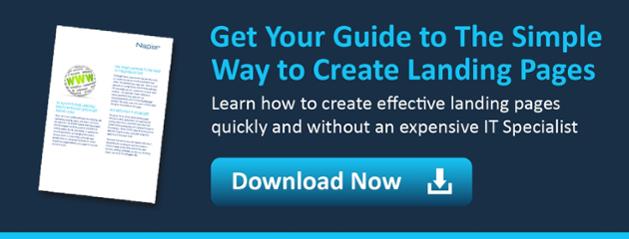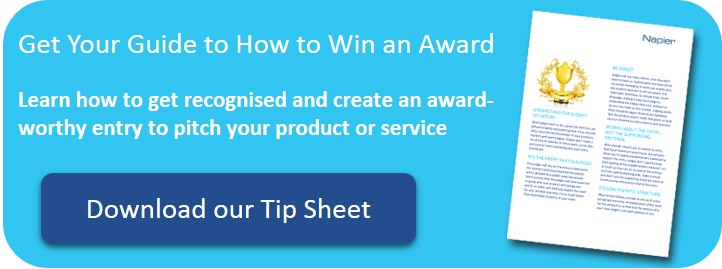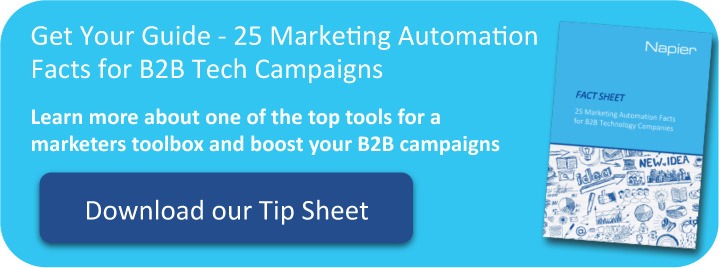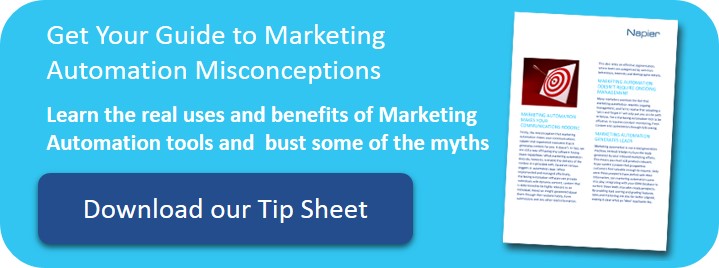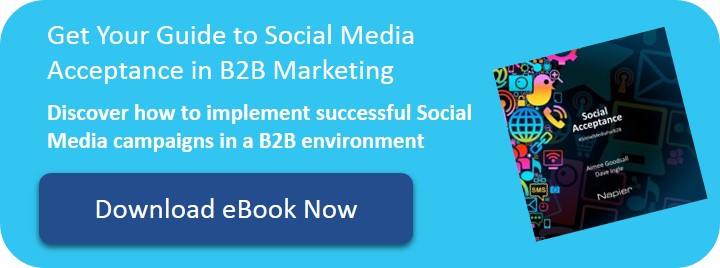The Anatomy of a Landing Page – Best Practises for Creating Successful Landing Pages
If you’ve read our previous post about landing pages, you’ll know why they are so valuable. Now you need to know what to do to make your landing pages successful. Creating a landing page is not just as simple as a page title and a form, there are some key best practises that you must follow.
Download The Simple Way to Create Landing Pages Tip Sheet.
Headline/Page Title - Your headline is the first thing that visitors see so it needs to be clear and sum up your offer accurately and meet visitor’s expectations.
Body text – Again this needs to clearly explain the content offer that will be given and show the true value of this, it should compel visitors to want to give you their prized personal details. This text needs to be short and simple, so bullet points are ideal as they are easy to digest.
Call To Action – This is the main event, this is why people have come to your landing page as it is the key to getting hold of the content so your call to action needs to stand out. If you’re using a button with overlaid text make sure to include an action word such as ‘get’ or ‘download’ so people feel compelled to take action.
Images – An image can really boost the effectiveness of your landing page if it is relevant and helps to spell out what your content offer is.
Keywords – You’ll no doubt have keywords that are relevant to your business and as with any of your other content, your keywords should be present on a landing page too in the title and the body text.
Lead Capture or Conversion Form – It goes without saying that you need to have a way of capturing your lead data. Make sure your form includes a sensible number of fields and asks for the right information. You might have the option to make some fields mandatory but making all fields mandatory can be a turn off, but only if your content offer doesn’t seem valuable enough. Don’t forget to ask for an email address or contact number. You may also have the option of using a verification service like captcha but ensure that if you use such a service it is not difficult to use as this would be an obstacle to potential conversions.
Remove Navigational Buttons/Other Links – A landing page needs to be free from distractions such as links to other pages or other offers, if it is to be its most successful. If you are trying to convert a visitor to a lead don’t confuse or distract them or give them the option of going elsewhere.
Social Sharing Buttons – There’s nothing more valuable than word of mouth advertising and this can translate online too. If a visitor sees real value in your content they might choose to share it with friends and colleagues…but only if you give them the option to! By including social sharing buttons you increase the likelihood that your supporters will promote your content for you, giving you even more opportunity to reach a wider audience and get more leads.
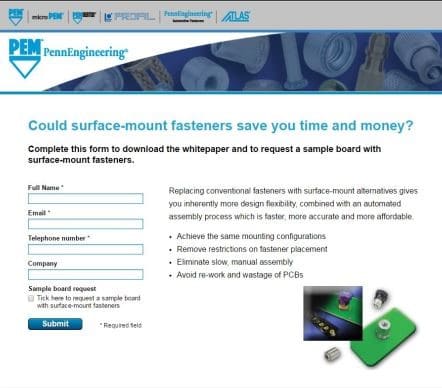
Now you know what you need to include on your landing page, there’s nothing else to do but take the plunge! If you want further advice on creating landing pages then download our tip sheet.
Three Reasons Why You Need to Be Using Landing Pages
Landing pages are a great tool for any marketing manager, so it is surprising to learn from MarketingSherpa’s landing page handbook that 44% of clicks for B2B companies are directed to the business’ homepage and not a dedicated landing page. Marketers feel the pressure to provide their sales team with leads and a good landing page can convert 20% of visitors in to leads, whereas home pages typically generate no leads at all. Understandably marketing managers are reluctant to pump money into the unknown and there is often the misconception that landing pages are complex, time consuming and expensive. Thankfully none of these things are true. When you understand how valuable landing pages can be for your business this statistic is mind boggling, so in this post we give you three reasons why you should be using landing pages to promote your business. To accompany this post we have also created a handy Tip Sheet that you can download .
Turning visitors into leads
One of a marketing managers main goals will be to drive traffic to an online resource to showcase what the company in question can do for potential customers. A website is a company’s virtual shop window so it is a valuable resource but how do you know how effective your website is at turning visitors into leads? A landing page is not just any webpage, it is a specific page with a purpose – to capture lead information. One of the major selling points of using landing pages is that they help increase your conversion rates and every business is interested in attracting more leads. As well as converting more visitors to leads, landing pages by nature attract better quality leads, as long as they are built and designed correctly and the right content offer is made available.
Learn more about your prospects
Every time a prospect fills out a form on one of your landing pages you are gaining valuable information about them that will help you in a number of ways. Understanding what type of visitors your content is attracting and then converting tells you whether your marketing strategy is successful and reaching the right audience. This in turn gives you insight into adjusting your buyer persona’s and tweaking your strategy if necessary. As an added bonus, this additional information also gives your sales team a great foundation to be able to make their follow up as effective as it can be. Over time, using landing pages are a great way to understand who your most engaged prospects are through reconversion's of existing leads, helping you to build your sales pipeline.
Supplement your other marketing channels
Landing pages need good quality content in order to be most effective and every time you create a new landing page you add another piece of content to your content calendar. Each new landing page can be shared on social channels and included in email campaigns. With each share you can track and analyse the associated metrics to see how your content performs. This detailed insight is a fantastic way to optimise and create compelling new content.
So there you have it, three really good reasons to use landing pages for your business – Happy Converting!
Get started by downloading our 'Create Simple Landing Pages' tip sheet
How to Win an Award Blog Series - 3. Is part of winning an industry award down to luck?
With any awards programme, there are factors you can control such as your choice of product, the category you choose to submit your entry into and of course what you choose to write or present. There are also factors that you cannot control that might affect your chances. In our latest blog about ‘How to Win an Award’ we give you some hints and tricks to maximise your chances. If you missed our previous posts in the series Choosing the Right Awards programme for Your Business and How To Write a Winning Awards Entry... make sure you take a read. If you're sure you're ready you can head straight to our Tip Sheet Download.
What a difference a judge makes
Depending on the subject area and who is organising the awards, the judges may be industry experts with a keen eye for the finer details who won’t be swayed by seductive language in your entry. Awards run by publications may have a judging panel made up of journalists and guest judges so you’ll need to aim to please as many of the panel as possible with a mix of technical and benefits driven messaging. If possible, it is always advisable to find out who is judging so you can tailor your entry to suit. If you can’t find out exact names then try to establish if they are engineers with specific field knowledge or whether they are technical journalists who are after the story. You can’t control who the judges are but knowing more about them and doing your research can at least put you a step ahead.
Who is the face of your entry?
If you need to present your award entry in person, then ensure you pick someone who knows their stuff and is furnished with the facts. Judges will see through sales patter and won’t have time for countless slides on the company history. If you’re entering a technical awards category make sure your representative can quote statistics or data that supports your entry and if possible choose someone who feels comfortable presenting and puts people at ease. Occasionally judges like to ask on the spot questions and your representative needs to be prepared with answers.
Who has the final say?
Some awards are judged behind closed doors and others are open to a public vote. If your chosen award is decided by the public (your industry peers) then make sure you promote your entry into the awards and ask your supporters to vote for you! You could include a link on your website homepage, on e-blasts, newsletters and through social media. Take your chance to influence the outcome by spreading the word as far and as wide as you can with compelling calls to action.
So, you’ve done all you can. You now have all the tools to write an award worthy entry! If you’re stuck for inspiration then download our Tip Sheet. If you want more of a helping hand why not get in touch and find out how we can help you to win an award.
How to Win an Award Blog Series - 2. How to write a winning awards entry
Before you begin, have you read our first post in the series? If not you can catch it here 1. Choosing the right awards programme for your business
You’ve established that you really do have the best product or service for an industry award. A team of people have been working hard behind the scenes to bring it to life and now is the time to shout about it. This should be the easy part surely? Interestingly, narrowing down what to say and how best to showcase your pride and joy can be a lot harder that at first glance. If you’re ready to put pen to paper (or fingers to keyboard) for your next award entry then read on to find out some crucial entry writing tips.
Style
If you’ve followed our tips from our previous blog post (link) you should know what format your award entry needs to take? Some awards programmes require a series of PowerPoint slides, some ask for a text only entry through an online form, or you may even be asked to present your entry in person to a panel. Knowing this information will give you an indication as to the breadth and depth of information that the judges are expecting and how many words you have to play with and whether or not you need high quality visuals to get your message across.
Structure
Depending on the format, you might not get any say in the structure of your entry. If you are filling in an online form, try taking down a note of all the questions into a word document and writing your answers in this document first before copying them into your final entry. This allows you to check for simple spelling and grammar errors as well as checking word count which can also be restrictive. If you have carte blanche to write as much as you want in whatever style you like, then follow a simple structure of a one paragraph overview, then clearly and concisely explain how your product/service meets the requirements. It is also important to make this information compelling to read. The judges may not be familiar with your company, so stress any key points by providing relevant data that shows an obvious need or demand for your product.
Substance
If you’re on a roll it can be hard to slow yourself down. Before you know if you’ve written a novel! Judge’s time for each entry is limited so make sure you get the key points across and highlight exactly why your product deserves an award. If you’re presenting your entry in person with a presentation, keep background slides about the history of the company to a minimum, one will do. If time is running short you need to be able to focus on the key messages about your product and how it meets the criteria. In contrast, some awards are also judged blind meaning that all mention of your company name or references that would make your company easily identifiable are removed. These types of awards mean that your entry really has to stand on its own two feet. If you are permitted to add additional supporting material, don’t spend too long on creating vast quantities of information. If you do want to include something, make it visual and don’t assume it will get seen.
If you’re ready to start crafting your entry why not download our tip sheet to keep handy whilst you write?
How to Win an Award Blog Series – 1. Choosing the right awards programme for your business
Winning an Industry award adds credibility, gives a brand great kudos and set’s you apart from the competition, which is great for brand awareness and publicity. But winning an award isn’t just about having a great product or service, you need to know how to sell it to the judges. Sadly, many great companies fail to take the top prize, not because their product wasn’t a worthy winner but their entry didn’t catch the judge’s eye. If you’re planning on entering an awards scheme this season, read our blog series for our top tips on what you need to do to win.
If you're ready to dive right in, you can download our 'How to Win an Award' tip sheet now but don't forget to come back to read the blog...
Picking the right awards to enter
In the B2B technology realm there are so many awards programmes to enter. Whilst this is great for the various industry sectors as it attracts attention for emerging and steadfast technologies alike, it can be tempting for companies to adopt a scattergun approach and enter them all, hoping that probability will mean you stand a better chance of winning. Sadly this tactic is fatally flawed. Industry awards simply don’t work that way. Awards are often aimed at a particular sector, vertical market or type of entrant.
Do your research and find out if your product or service really fits with the overall ‘vision’ of the awards - will entering and subsequently winning, place you in front of the right people? If you’re spending time on an entry, the outcome and associated exposure needs to be relevant and worth the investment of time and in some cases, money.
Read and understand the entrance criteria
Do you remember what your teachers used to say at school? Read the question! This may sound obvious enough but you would be surprised at the number of entries that miss this vital step. Make sure you understand what the judges are looking for and don’t be tempted to include every last scrap of information about your product or service as Judges are often short on time. Naturally you are excited about the prospect of winning and what this could mean for your business but don’t let this cloud your judgement, be honest and realistic. Judges will instantly throw out irrelevant or poorly thought out entries.
Put your best foot forward
Picking the right awards programme to enter is only part of the battle, you also need to make sure you enter the best product or service that meets the category criteria. Sure, you might have just launched an all singing and all dancing product, but think carefully. If the entry requires data and statistics to back up your claims, can you provide this information to support your entry if your product is new in the field? A new product would be better suited to an ‘innovation’ or emerging category.
This is only the beginning to crafting the best award entry and there’s plenty more meat to flesh out the bones. If you’re planning an awards entry, make sure you download our tip sheet and read the next blog in the series.
Marketing Automation for a Happier, More Profitable Sales Team
There are really only two reasons why companies need marketing and PR, either they have something to sell or they want to raise their profile. Marketing and Sales teams need to work together in order to meet sales targets and often there is a degree of tension between these two departments as Sales want better quality leads from the Marketing team. Marketing Automation can improve this relationship and boost the bottom line, making a happier and more profitable sales team…but how?
- Build the Sales Funnel
Anyone knows that the more opportunities the sales team have, the better the chances of success. Marketing automation enables businesses like yours the chance to track prospects activity on your website as well as offering real-time alerts to provide better lead targeting. This level of insight means that leads can be qualified and profiled for further nurturing if necessary, or followed up immediately. This visibility gives the sales team a clearer view of the potential work ahead and helps them to build their sales funnel accordingly.
- Get More For Less
Traditionally the sales representative has had to make regular visits, delivering doughnuts for an excuse to have a regular catch up and to stay in touch. Many hours have been spent driving around the country, racking up expense claims for the mileage and the goodies. But lead nurturing doesn't need to be so hands on, or so time consuming. Marketing automation allows companies to get more from their sales team by keeping them off the road and focussing purely on the genuine leads that can bring in business, the people that have visited your site regularly, downloaded your content and shown they are keen to know more and not just interested in the doughnuts. Nurturing leads the smart way means less sales visits but more revenue and commission. What’s not to like?
- Staying at The Top
One of the main problems with nurturing leads the old fashioned way is having to stay on top of your list of contacts, keeping track of who you spoke to or emailed and when. Keeping in touch regularly with an ever growing list of contacts is tough and research shows that people have to see something 7 times before they take action. So how is this manageable? With marketing automation, staying ‘top of mind’ is easy, contacts are not repeatedly spammed but are emailed at just the right frequency based on pre-set triggers that dictate the next appropriate sales action. As contacts become more engaged their experience is tailored, giving them a better experience all round.
Interested to find out how marketing automation could work for you? Download out Tip Sheet or get in touch
Myth-Busting Marketing Automation - 3 Things You Need To Know
The use of marketing automation software is increasingly more common yet many marketing managers are still concerned about investing money in new tools. Marketing automation won’t be suitable for every B2B organisation, but for companies that have a longer buying cycle, or a variety of markets to serve, sending sporadic emails or making phone calls once a week simply doesn’t cut it. There are still a few misconceptions surrounding marketing automation, what it does and how it can be used to its best advantage, and below we set the record straight with some myth-busting.
- Marketing Automation is only for large companies
This really isn’t the case. It’s true that marketing automation isn’t suited to every business but the size of the business isn’t the reason. Marketing automation works best when the business has a clear idea of the markets they want to serve and have the means to serve them with great marketing content and clearly defined products and services providing solutions to their customer’s problems.
- Marketing communication will become generalised and robotic if you use marketing automation
Absolutely not. The first error in this misconception is that this viewpoint assumes that marketing automation generates content. This is not possible (yet) and we’re still a way off having such sophisticated software to make this possible. What marketing automation does do is deliver content that has been created to the right audience, based on a series of automated steps or triggers that can be configured. When a strategy is put in place and managed effectively, marketing automation increases engagement and gives companies real insight based on their visitor’s website behaviour such as form submissions that act as lead capture.
- Marketing Automation software generates leads
It is not the marketing automation software that generates the leads, your content still has to do that job. The platform you choose simply helps you to nurture or process the lead data, to make it more manageable. Marketing Automation cannot work miracles, you still need to produce valuable content that your visitors want to consume. Once you have them interested enough to hand over their personal data, marketing automation steps in, shepherding them through to the next step in the journey. Marketing automation software integrates with most CRM systems which then enables these leads to be nurtured into sales ready prospects. Being able to identify and categorise leads makes for better follow up and a better chance for conversion which will please both marketing and sales teams alike.
Now you know the truth about marketing automation, it’s time to take the next step. See for yourself the success that companies have in using marketing automation with a short overview from Napier client Vicor.
5 Key Facts About Marketing Automation for B2B Marketing
How do you promote your company? I’m betting you'll have a website, pretty standard in today’s times. Maybe you run print ad’s in trade publications or possibly even banners or pop ups online? You might even be investing in Social Media? So you're putting all this effort in but I bet you're wondering...where are all the leads? Who is looking at my website and what are they interested in? Why aren’t the phones ringing off the hook? Sure, Google Analytics can give you an indication of your website statistics but there is no actionable data, no tangible leads to follow up. What one thing can you do to change this and get more bang for your buck? It's time you considered marketing automation. Marketing automation is widely recognised in B2B sectors as being a game changer. Here are 5 key facts that you need to know about how marketing automation can help your business.
Build your Pipeline – B2B marketers who implement a marketing automation strategy using marketing automation software such as Hubspot increase their sales pipeline contribution by an average of 10%. Think about your bottom line, what could that extra 10% mean to you and your sales team?
Small Businesses can benefit too – you might be thinking that only global businesses can make use of marketing automation, but you’d be wrong! The Hubspot platform is the leading automation platform for small businesses. Marketing automation is perfect for businesses with a niche focus or those who serve a number of audiences. Marketing automation gives you the power to deliver the right messages to the right people at the right time.
More opportunities – we’re all busy. Our calendars are full of reminders and appointments but what if marketing automation could relieve the stress of following up prospects? 67% of B2B marketers have seen at least a 10% increase in sales opportunities through lead nurturing with marketing automation, with 15% seeing their sales opportunities increase by 30% or more.
Better Leads – The top benefit of using marketing automation, according to those already working with a platform, is the increase in lead quality, therefore increasing your chance of conversion.
Lowering Costs – That’s right, marketing automation can save you money! In a report by Demand Metric, marketing automation using the ‘Inbound’ approach costs 62% less per lead that traditional outbound or interruptive marketing.
So there you have it. Five really great reasons to take the next step and find out how marketing automation could boost your business. If you want to read more on marketing automation then download our guide - 25 Marketing Automation Facts below.
Bill Barron joins OpenSystems Media
Well-known industry veteran Bill Barron has been appointed Strategic Account Manager at OpenSystems Media. Prior to joining the OMS Team Bill spent 11 years at Hearst Business Media as VP and Publisher as well as holding positions at PartMiner as CMO and Publisher at CMP. Bill steered Hearst Business Media to a leading position before selling the group in 2015.
The Hearst Business Media Group had a reputation as a technology leader providing information, insights and solutions to professionals around the world in finance, healthcare and transportation. Electronic Products magazine is one of the most well-known publications that belonged to the Hearst Business Media group before being bought by AspenCore back in December 2015 and it’s a firm favourite with Napier clients.
OpenSystems Media has been a leading publisher of electronics magazines, e-mail newsletters, websites, and product resource guides for more than 33 years. A key resource for engineers, OSM produces e-casts, live and virtual technical events and interactive tools. They are also the largest producer of lead generation tools such as webcasts and whitepapers by driving awareness through social media.
On his move to OSM Bill says, After spending time with OpenSystems Media, I am very excited about the possibilities. I've learned OSM has many unique and innovative products and services that my prior customers will love to take advantage of. I look forward to being part of the team and getting out there to tell the OSM story”.
This move is an exciting one for OpenSystems Media and Bill with publisher and partner Patrick Hopper revealing, “We are very excited to have Bill working with us…Bill will help Open Systems Media expand our presence across all of our brands.”
We look forward to working with Bill in his new role at OpenSystems Media and seeing our client’s coverage in their key publications such as Embedded Computing Design.
Napier Welcomes Kate Thomsen as Executive Assistant

Kate brings with her over 20 year’s experience of working in Executive Administration, having been a PA for some of London’s top creative digital and media agencies such as Lowe & Partners Worldwide, Publicis, DDB and Omnicom. Kate will be supporting the Directors on a daily basis, co-ordinating their busy schedules, as well as assisting with HR and aspects of Marketing. Having extensive experience with event management, hospitality and logistics, Kate will also be supporting the Napier team with the numerous projects they undertake.
We are excited to have Kate on Board and she is raring to go…Welcome to the team Kate!
Three Top Tips for Generating Leads Through Social Media
With marketing managers often under pressure to help generate leads for the sales team and raise awareness of the company brand, social media is a great tool at your disposal. But just how effective is it? It’s true that in the B2B technology sector, the use of social media is lower than in many other industries. We undertook a comprehensive survey and followed this up with a subsequent investigation to examine how attitudes had changed over time. We made some interesting discoveries that any B2B company can use to increase their business potential through the use of social media.
The fact is, social media can be a great tool for lead gen and awareness. Here are our three top tips for generating leads through social media:
Be human
Okay, so we know we have a hurdle to overcome with slow uptake in some industries. Whilst social media may be blocked at work, company employees are still human and will inevitably browse social media sites in their own time. Social media is great for building awareness, so don’t just assume that if a company is not engaging with you directly that their employees aren’t from another account.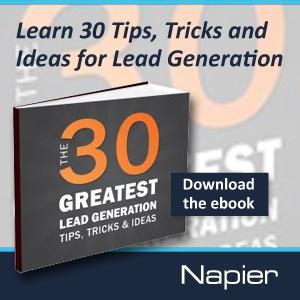
Have an ear to the ground
Social media isn’t just about broadcasting, it’s about listening too. Use various social media platforms and tools to monitor what is being discussed, and share online. Monitor your own channels to see what content is being engaged with, and monitor the competition to see what seems to be working for them, or where you can fill in the gaps that they have missed. Examples of tools that I use include Foller.me, Followerwonk and Tweetdeck. These tools help me monitor hashtags, trending topics and learn more about other accounts of interest, including the competition. Using these tools has definitely helped my clients find new leads, and who doesn’t want more leads?
Less is more
A clichéd phrase I know, but social media is often seen as a time vacuum, and it really doesn’t need to be. Scheduling tools are not new, but they are still highly effective. It is important, however, to use one that works for you. I personally use Buffer as it integrates with all of the key social media platforms, including Tweetdeck, so I never need to worry that things will go awry. Continuity is key, so check that your tools are working for you as well as they could. If not, try something else…Don’t fear change.
While these tips for generating leads through social media are indeed common sense, sometimes as marketers we need a little reminder on how to make the most of even the basics. For more social media tips and tools to help with lead generation and increasing brand awareness, download our free guide to using social media in a B2B environment now.
New Editor, New Era for CIE Magazine
Multimedia Journalism graduate Amy Wallington begins her Editorial career at CIE Magazine. After graduating university in 2015 having specialised in print and online journalism, Amy is new to the world of Electronics. Heading up her own Radio show for BRFM she is no stranger to carving out an audience and immersing herself in the community.
Amy takes over editorship from Joe Bush, who dedicated 8 years to Electrical Engineering magazine and replaced Neil Tyler at CIE in 2014.
CIE magazine is now in its 25th year and serves design engineers by providing the latest information, in-depth analysis of trends and new developments in the electronics industry. With the addition of CIEONLINE, engineers have even more news directly in their inboxes, with access to whitepapers, videos and industry interviews.
Amy’s appointment is exciting for both her and the publication with Managing Editor Neil mead revealing, “She is incredibly enthusiastic…she will be a great asset to the team…and will bring lots of new ideas to help develop CIE for the future.
Here at Napier we are already working with Amy in her new role as she helps us to support our clients and we wish her all the best in her new career.

